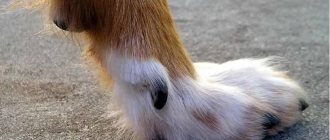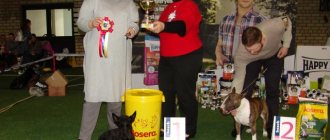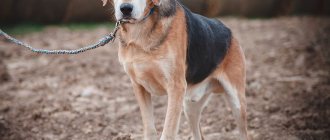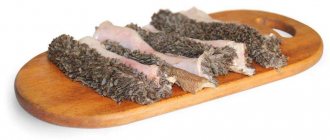Features of the structure of paws, or How many toes do dogs have
For many people, a dog is an equal member of the family that requires care and attention. Once upon a time they were faced with a choice: to have a four-legged friend or not. With the advent of a small pet, all doubts disappear.
Dog breeders are ready to constantly take care of their animal. And the situation related to dogs, which is described in this article, requires special attention. But first, you need to answer the question: how many fingers do dogs really have (including yours)?
How is a dog's paw constructed?
A dog is a digitigrade animal, which means that it is the toes that cope with more load during walking and running than the heels.
A dog's paw has 4 toes. But there are breeds of animals that can have 5 or even 6 fingers. These “extra” fingers are called dewclaws. Most often found on the hind legs, and sometimes on both legs at once. This is due, first of all, to the fact that most breeds of this animal originated from the wolf (huskies, hounds).
Atavism is the appearance of an extra toe on a dog’s paw. It is possible that wolves are also susceptible to this feature, but they are not under supervision, and it is impossible to say for sure about this.
There are as many toes on the hind paws as there are toes on the dog's front paws. Unlike people, they cannot move them, but they still have mobility. Animals walk as if on tiptoes, thanks to which they are able to quickly change the direction of running.
Cause of dewclaws
Organs that are underdeveloped or have lost their basic functionality in the process of evolutionary development are called rudimentary. This includes not only the fifth toe in dogs. Humans also have vestigial organs, such as wisdom teeth, muscles that allow the pinna to move, the tailbone, and the appendix.
The exact reasons for the appearance of dewclaws in domestic dogs, and less commonly in cats, have not been identified. The anomaly can also appear in the descendants of dogs that did not have such changes.
Under normal development conditions, a newborn puppy should have 5 fingers on the thoracic limbs and 4 on the pelvic limbs.
But some dogs have not 4 toes on one paw, but 5 or even 6 on their hind legs. Two extra toes are called dewclaws, and the anomaly itself is called polydactyly.
For hunting dogs, polydactyly is a real defect that does not allow the animal to develop normal speed or walk quickly. Rudimentary toes on the hind limbs can cling to various objects while walking - tree branches, moss and turf, which leads to pain and inflammation. All this together significantly reduces the dog’s ability to hunt normally. It is also important that the presence of extra toes on the hind limbs is a hereditary factor and is passed on from generation to generation.
A dog is by no means defective if it was born with extra fingers, but it does not give it any special abilities. This anomaly is not a deformity, but it can ruin the life of the dog and the owner himself. On such rudimentary fingers, as a rule, claws grow, which must be trimmed. Moreover, the dewclaws on the hind legs often cling to the fleecy covering and the animal can injure itself completely independently by sharply jerking the limb.
Why does an extra finger appear?
Experts say that the appearance of an extra toe in a dog is a manifestation of atavism. Atavism is a biological process of manifestation in an animal of signs of the class or group whose representatives participated in the breeding of this organism. Over time, these signs lose their functions.
If we talk about how many fingers most dogs should have, then according to the law of biology - 5, perhaps, like their distant genetic ancestor - the wolf. This means that the appearance of an extra finger is a natural pattern.
There is still a debate among experts about why some puppies develop such a toe and others do not. There is an opinion that this is due to the fact that the sign of the appearance of an extra element is a suppressive process. And if you cross a male with five fingers with a female with a normal paw, then the puppies will most likely be born like the father.
Is the fifth finger useful?
If your pet is found to have an extra finger, then there is no need to sound the alarm; this phenomenon is not abnormal or pathological. This feature is acceptable, and in some cases is the norm. Certain dog breeds have a fifth toe, such as hounds, huskies, or Beaucerons. Such an element, so to speak, speaks of purebredness and thoroughbredness.
For dog breeders who are keen on hunting, the presence of a dewclaw in a pet is only an aesthetic problem. During a hunt, a dog has to move much faster than in normal living conditions. In this case, the extra element on the paw interferes with running in tall grass or thickets. A protruding finger clings to grass, mud, snow and twigs in every possible way, making walking difficult.
Care for dewclaws
If the breeder decides not to amputate the 5th finger of his pet, then he must properly care for him. All procedures are carried out in the same way as with the animal’s ordinary fingers: it is necessary to trim the claws in a timely manner and ensure that the dog does not injure the rudiment. But, if the claws grow incorrectly, dig into the skin, and cause discomfort to the dog, then veterinarians recommend thinking about the procedure for removing the dewclaw.
Read Causes of hematobartonellosis in dogs: signs and methods of treatment
Whether or not to amputate a puppy's 5th toe is the owner's decision. Before making a decision, the owner should think about the animal’s lifestyle: whether the owner can care for the 5th toe without injury. Grooming, bathing or combing the animal should be done with extreme caution. An extra finger should not interfere with walks and exhibitions.
Should I remove the wolf feature or not?
Surgical removal is performed, the complexity of which depends on how many toes the dogs are considered to have extra, and on how many paws. The procedure is simple and painless. Dogs easily tolerate the operation, which is performed under local anesthesia in half an hour.
It is important to know that surgical removal is not performed on newborn puppies. It’s better to wait until the little dog’s body gets stronger.
This procedure is not necessary for dogs with five toes. Most dog breeders are in no hurry to remove this aesthetic problem, and they are not particularly interested in how many toes a dog has. It is better to remove extra toes on the front paws, as opposed to the hind paws, because they fit tightly to the skin and interfere with walking.
There are cases when dogs refused to move at all, and the whole problem was that fingers with untrimmed claws interfered with running and caused pain.
How does amputation occur?
Some dog owners, instead of seeking professional help, carry out the amputation themselves. But it would seem that the simplest operation can only harm the puppy: the owner will simply remove the rudiment incorrectly and in adulthood the pet will have to resort to removing the dewclaw again. If amputation is carried out without pain relief, the puppy will develop pain shock and the animal may die. Also, the puppy may develop an allergic reaction to the anesthesia; due to swelling of the larynx, the pet may die.
Veterinarians recommend removing the fifth toe in puppies when the risk of complications is minimal. A one-week-old puppy has a weak pain threshold, so amputation of the dewclaw is easier to tolerate than in adult dogs. The operation is performed under local anesthesia or general anesthesia, depending on the age of the pet. Surgical intervention is easily tolerated and does not pose a threat to the life of the animal. In adult dogs, the rudiment is removed after injury.
Fixation of the patient
Before amputation of the rudiment begins, the veterinarian fixes the animal. The method of immobilization depends on the age of the dog:
- A puppy up to a week of age is fixed by the owner. The breeder simply holds the pet tightly in his arms.
- An adult dog is immobilized on the operating table. The doctor selects the most comfortable position: on the left side or abdominal position.
If the animal is poorly secured, then during the removal of the rudiment, the veterinarian may involuntarily inflict a cut wound with a scalpel.
Anesthesia
The anesthesia procedure is selected for dogs depending on their age:
- Puppy. If the pet is less than a week old, the veterinarian will administer local anesthesia. The puppy is first injected with novocaine using the infiltration method.
- Adult dog. For adult dogs, amputation of the fifth toe is performed under general anesthesia.
Read Symptoms of arthritis in dogs: 10 best drugs for treatment
If the puppy did not have time to remove the rudiment before the age of one week, then the operation is postponed. In this case, the veterinarian will resort to surgical intervention when the dog reaches 12-16 weeks.
Progress of the operation
Removal of the 5th toe in puppies is carried out in a veterinary clinic where sanitary standards are observed. Before removing the vestige, the operating room is disinfected and instruments are sterilized. The course of the operation depends on the attachment of the rudiment:
- If the rudiment is attached to the skin, the veterinarian removes it using scissors and a scalpel.
- If the rudiment is connected to the bone by a phalanx, then the veterinarian will remove the second phalanx with a scalpel.
After the operation, the puppy may notice some bleeding. After stopping, the dog is given stitches and a sterile bandage. To prevent the puppy from developing stress, the doctor can sew the wound with self-absorbable threads - catgut.
Interesting! The operation to remove the rudiment is considered an easy manipulation. And the whole procedure lasts no more than 20 minutes.
Hygiene issues
Paws require special care, no matter how many toes a dog has. Hygiene issues become important when dogs live in the same premises as their owners. The animal must be walked twice a day in all weather conditions, which include bacteria, dirt and dust.
Dirt, dust and small particles can be absorbed into the skin and harm the pet's health. This means that it is not enough to simply wipe the dog’s paws with a dry cloth; a thorough wash is necessary.
Only proper and regular care will ensure good health for your pet.
What can a dog's paw do?
The functions of dog paws can be analyzed using the example of its components:
- Claws . Compared to human nails, a dog's or even a puppy's claws are thicker and stronger, making it easy to dig holes and maintain stability. Its direct purpose (killing prey) is rarely used, since the role of a companion does not imply an independent search for food.
- pads. Indispensable as:
- Shock absorbers . They reduce the load on bone tissue, help with sudden braking, maintain stability and protect joints from wear.
- Hot water bottles . The presence of blood vessels protects against hypothermia, but makes the animal vulnerable to hot asphalt.
- Sweating regulator . Sweat glands, located in the inner layer, moisturize the skin and allow you to mark objects and territory.
- Fingers . They perform the function of human heels and take the main load during movement. The finger located next to the wrist is called the dewclaw and is used for grasping and holding objects.
A dog's paw consists of claws, toes and pads.
Peculiarities
Among the features characteristic of dog paws are:
- Lack of ability to hide claws and move fingers.
- A special manner of movement . Animals walk on their toes, avoiding contact of their heels and wrists with the ground.
- Ability to produce a sweet popcorn aroma . This is due to bacteria formed by wet microflora on sweaty pads and is observed in decorative dogs that rarely go outside.
- Expression of fear through sweat glands . Four-legged friends are also capable of experiencing a state of “cold sweat”. The secret they leave is also read by other dogs, who take over the underlying anxiety.
- The presence of a special system of arteries that heat frozen blood and regulate a constant temperature. Even -35 degrees is not scary for dogs. Only dolphins and penguins can boast of such abilities.
Developmental anomalies
Anomalies include the dewclaw on the hind legs and the second dewclaw on the front legs.
When a dewclaw develops, it must be removed
The 5th (or 6th) finger is an atavism inherited from wolves, but has lost its power and strength. It is underdeveloped, has a curved claw and spoils the aesthetic appearance of the pet. In addition to aesthetics, the claw on the dewclaw clings to surrounding objects, and its injury leads to unpleasant consequences.
In conclusion, let me remind you that dogs should normally have 18 toes: 4 on the back and 5 on the front. Any deviations are considered anomalies and require a veterinary opinion.
Please note that removal of extra toes is only allowed during puppyhood.
Do I need to remove the rudiments?
Dewclaws of the hind limbs are not considered a pathology and it is not necessary to remove them. Veterinarians recommend operating on puppies to avoid possible complications:
- injuries while walking, running;
- inconvenience in caring for the dog: cutting, combing; bathing;
- ingrowth of the nail into the skin.
It is mandatory to remove a finger in case of diseases of the dog’s paws. Such diseases include:
- necrosis – tissue death;
- osteosarcoma;
- gangrene;
- osteomyelitis;
- dewclaw injury.
There is also a group of dogs that will have to have their dewclaw removed:
- Hunting breeds. Due to the rudiment, it becomes difficult to move through thickets and forests. The fifth finger will simply cling to branches and grass, which can injure the animal.
- Show dogs. If a dog is being prepared for a show, then removal of the rudiment is mandatory during puppyhood. But there is an exception: it is forbidden for the Pyrenean Mountain Dog and Biard to remove the rudiment before the exhibition. The appearance of the 5th finger indicates their purebred.
Read Causes of adenovirus infection in dogs: signs and methods of treatment
To reduce the risk of injury, veterinarians recommend removing dewclaws from puppies under one week of age. During this period, the puppy will not feel severe pain, and the recovery process will go quickly.
How many toes does a dog have
Dogs belong to the category of digitigrade animals. This means that when they move, their heels and wrists don't touch the ground, and their toes take most of the weight, so they appear to be walking on their tiptoes. Thanks to this feature, they can suddenly change the direction of movement, jump to the side and perform other “maneuvers”. Compared to humans, dogs' fingers are very short, and pets cannot move them. Since the interdigital space is minimal, only some of their mobility is preserved.
Should a dog's dewclaws be removed?
To understand whether you need to take your dog to the veterinarian to have the extra toes removed, you need to think about it carefully. In the capital, fingers are removed at a cost from 300-500 rubles to 1400-2000 rubles, it all depends on the age of the dog. The older the pet, the more expensive the surgical intervention:
- In some breeds (shepherd dogs, German husky, mastiff), a dewclaw on the hind legs is a sign of purebred.
- Usually the fifth toe is cut out for working and hunting dogs, that is, for those whose workload is greater than that of other pets.
- It is best to remove dewclaws in infancy, when the puppy is 1 week old. At an older age, the operation will be under general anesthesia, which can negatively affect the dog’s health.
- Some people advise removing the toes of newborn puppies at home without the help of a veterinarian. It's a delusion. It is very dangerous. There is a risk of infection, painful shock and blood loss.
- Sometimes dogs are hampered not by the extra fingers themselves, but by the long and curved claws that grow in them. In such situations, it is better to trim the nails rather than remove the toes.
Now you know how many toes a dog should have.
Dogs belong to the category of digitigrade animals. This means that when they move, their heels and wrists don't touch the ground, and their toes take most of the weight, so they appear to be walking on their tiptoes. Thanks to this feature, they can suddenly change the direction of movement, jump to the side and perform other “maneuvers”. Compared to humans, dogs' fingers are very short, and pets cannot move them. Since the interdigital space is minimal, only some of their mobility is preserved.
Number of toes on a dog's paws
It is believed that normally, dogs, regardless of gender, age and breed, have five toes on their front paws (four main and the fifth is an additional one) and four on their hind paws. But there are also individuals that can have five toes on their hind limbs. Such additional elements are called dewclaws or wolf claws, and their appearance is an atavism (a feature that was present in distant ancestors, but lost its functions over time).
On a note! The dewclaws of the dog's forelimbs can be used when chewing bones or toys, as they help to grasp and better hold the object. They are also said to provide better traction, allowing the animal to remain stable while moving over rough and uneven surfaces at high speed.
Experts cannot clearly determine why some puppies develop a dewclaw and others do not. Some are confident that a suppressive gene is responsible for the appearance of the extra element, therefore, when crossing a female with a normal paw and a male with atavism, in most cases puppies are born with paws like the father’s.
Exceptions to the rules
For most breeds, the presence of such a toe on the hind legs is considered a defect, so such animals may not be allowed to participate in exhibitions. But for certain breeds, five-toed hind limbs are an integral confirmation of the purity and quality of the breed, which is enshrined in the standards. If during the exhibition the expert does not count the required number, the animal can simply be removed from the ring. These breeds include:
- Nenets Laika (reindeer Spitz);
- Briard (French Shepherd);
- Pyrenean Mastiff (Pyrenean mountain dog);
- Beauceron (French Shepherd)
- Catalan Shepherd.
For all other breeds, experts often recommend removing the dewclaws of the hind limbs in early puppyhood (on days 3-6). They do not provide any useful function during movement, but can get caught on something and even come off during games, training and other activities. This is especially true for dog owners who are keen on hunting: the presence of an additional appendage on the hind legs can bring additional difficulties. During the hunt, the dog must move much faster than in everyday life, and the extra element on the paws will interfere with movement in the thickets and cling to mud or branches.
The number of toes a dog has is not an indicator of its health status and the presence of the “fifth element” is not considered a pathology. Competent and thorough paw care is of primary importance for health. Regular bathing, starting in puppyhood, will prevent the development of unpleasant odors and fungal diseases, and massaging the paws between the pads will improve blood circulation and help relax the limbs.
Sources:
https://fb.ru/article/280965/osobennosti-stroeniya-lap-ili-skolko-paltsev-u-sobak https://kotsobaka.com/sobaki/skolko-palciev.html https://usatiki.ru/ skolko-paltsev-u-sobaki/
Where does a dog get its fifth toe?
In most cases, dogs have 5 toes on their front paws. This is the norm. But the fifth toe on the hind legs is not always found. Usually it is called the dewy, less often - the wolf. It is assumed that modern dogs inherited this atavism from wolves, since they were often bred with them in the past in order to consolidate beneficial qualities.
An extra claw on a front paw is not actually an atavism: it can be used by dogs to hold objects
In the case of some breeds, the presence of a fifth toe indicates purebredness. This is true, for example, for the French Shepherd, Pyrenean Mastiff and Nenets Laika.
A dewclaw on the hind paw most often bothers dogs. It is not connected to the muscles by flexible cartilage, so it is immobile. The pet also cannot retract its claw, so with an active lifestyle it will inevitably cling to ledges, sticks, etc. This often leads to injuries. To prevent this, the fifth finger is removed.











